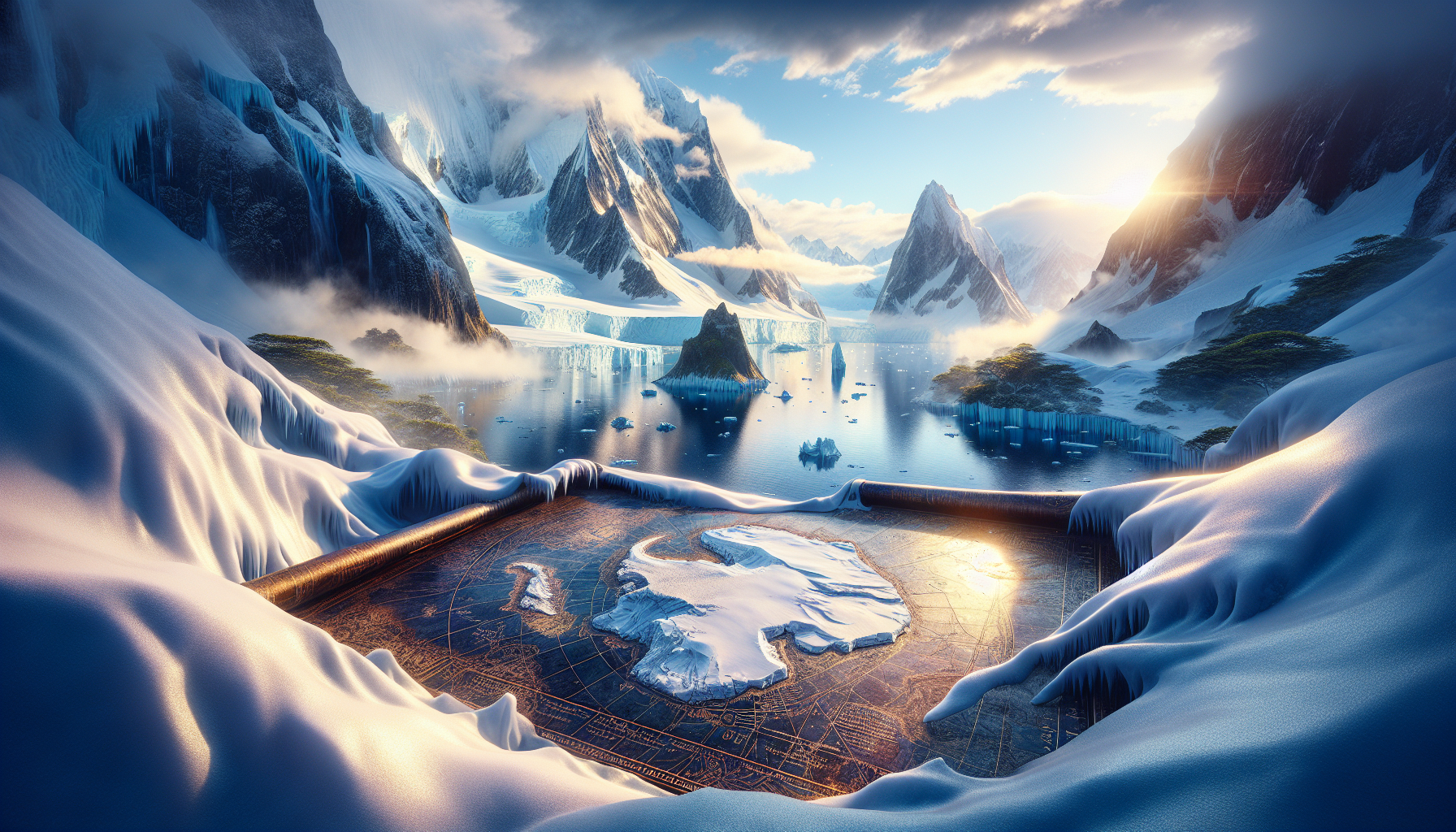In the vast expanse of our planet, few places ignite the imagination quite like Antarctica. A frozen realm of stark beauty and formidable challenges, it has long captured the curiosity of explorers, scientists, and dreamers alike. Yet, beneath its icy veneer lies a tapestry of secrets waiting to be unveiled. Imagine, if you will, a map that defies conventional understanding—a map that hints at lush landscapes and temperate climes hidden within the frosty embrace of Antarctica. This is not merely the stuff of science fiction, but a tantalizing possibility brought to light by a series of intriguing forged maps, each whispering of a tropical paradise cloaked in snow and ice. 🗺️
As we delve into this fascinating subject, we embark on a journey through time and imagination, exploring the origins and implications of these mysterious maps. Could they hold clues to a prehistoric Antarctica, one that thrived with life before the ice claimed its dominion? Or are they nothing more than elaborate hoaxes, crafted to stir the pot of cartographic curiosity? This article will unravel the enigma of these forged maps, inviting you to consider the geological, historical, and cultural narratives that intersect in this frozen frontier.
In our exploration, we will first trace the history of Antarctic exploration, highlighting the brave souls who dared to venture into the unknown, and how their discoveries shaped our understanding of this remote continent. From there, we’ll delve into the emergence of these maps, examining their provenance and the controversies they have sparked among historians and geographers. Are they remnants of ancient civilizations with knowledge lost to time, or merely the product of human imagination pushing the boundaries of the known world?
Finally, we will consider the broader implications of a “tropical Antarctica,” looking at the scientific possibilities and the impact on our understanding of climate change and Earth’s ever-shifting landscapes. By the end of this article, you’ll find yourself questioning what you know about Antarctica and pondering the endless mysteries that lie beneath its icy surface. So, prepare to be captivated by tales of adventure, intrigue, and the unyielding human spirit as we uncover the mystery of tropical Antarctica through the lens of forged maps. 🧭🌍
The Enigmatic Antarctic: Beyond the Ice
The common perception of Antarctica is a vast, icy desert, isolated from the rest of the world, primarily explored by scientists and a few adventurous souls. However, recent discussions have sparked interest around the possibility of a much more tropical past for this frozen continent, leading many to question the historical narratives we hold about it. This article delves into the tantalizing mystery surrounding the ancient maps that suggest a verdant Antarctica, and the implications such revelations could have on our understanding of history and geography.
Ancient Maps and Their Mysteries
One of the most intriguing pieces of evidence supporting the theory of a tropical Antarctica comes from ancient maps. Among these, the Piri Reis map, created in 1513, is particularly fascinating. This map, drawn by the Ottoman admiral and cartographer Piri Reis, depicts parts of the Antarctic coast free from ice. What’s extraordinary is that the continent wasn’t officially discovered until 1820, raising the question of how Piri Reis could have known of its existence, let alone its geographical features.
Another remarkable map is the Oronteus Finaeus map from 1531, which also shows Antarctica with an ice-free coastline. These maps have led to numerous speculations, with some historians suggesting that ancient civilizations may have had the capability to explore and chart these distant lands long before modern explorers. The details found in these maps are so precise that it challenges our understanding of the capabilities and reach of ancient cartographers.
Recent scientific studies have supported the idea that Antarctica wasn’t always the icy wasteland we see today. Geological evidence suggests that the continent was once part of the supercontinent Gondwana and had a much warmer climate millions of years ago, covered by lush forests and diverse wildlife. This aligns with the mysterious depictions found in ancient maps, potentially indicating that they were based on sources dating back to when the continent was indeed ice-free.
Modern Exploration and Discoveries
Modern technology and exploration have brought to light more secrets hidden beneath Antarctica’s thick ice sheets. Through the use of satellite imagery, ice-penetrating radar, and other advanced techniques, scientists have discovered vast subglacial lakes and mountain ranges, such as the Gamburtsev Mountains, that rival the Alps in size but are completely buried under ice.
These discoveries suggest a vibrant ecosystem beneath the ice, with microorganisms thriving in these extreme conditions. The notion of life existing in such a harsh environment opens up possibilities for understanding how life might exist on other planets, especially those with icy exteriors. These findings challenge the perception of Antarctica as a barren, lifeless place and hint at a much more complex ecosystem that might have existed in its warmer past.
Furthermore, international collaborations, such as the Antarctic Treaty System, have enabled scientists from around the world to work together to study this unique continent. These efforts are not only uncovering the secrets of Antarctica’s past but are also crucial in understanding the global climate system and the impacts of climate change, as the melting of Antarctic ice has direct consequences on sea-level rise worldwide.
Unveiling Historical Narratives
The existence of these ancient maps and modern scientific discoveries force us to reconsider historical narratives about human exploration and geographical knowledge. The idea that ancient civilizations might have been more advanced in their geographical understanding than previously thought is both intriguing and challenging. It suggests that there may be lost chapters in human history that have yet to be rediscovered.
Impact on Cultural Perceptions
These revelations about Antarctica have cultural implications as well. The continent has often been seen as a symbol of isolation and desolation, but the possibility of a tropical past redefines it as a place of mystery and potential. This change in perception could inspire new cultural narratives and artistic expressions, exploring themes of lost civilizations and ancient knowledge.
Moreover, these discoveries could shift our understanding of human migration and interaction with different environments. If ancient civilizations had the means to explore and map Antarctica, it implies a level of maritime skill and curiosity that aligns with tales of legendary sea voyages found in various cultures.
Additionally, these insights could impact modern geopolitics, as nations with claims in Antarctica might reconsider the value of the region, not only for its scientific importance but also for its historical and cultural significance. Such a shift could lead to increased interest and investment in Antarctic research and conservation efforts.
Scientific and Technological Advancements
Exploring the mysteries of Antarctica has driven significant advancements in science and technology. The need to study the continent’s hidden landscapes has led to the development of cutting-edge tools and methodologies, such as ice core drilling techniques and autonomous underwater vehicles designed to explore subglacial lakes.
These technological innovations have applications beyond Antarctica, contributing to our understanding of Earth’s climate history and aiding in the exploration of other extreme environments on our planet and in space. For instance, the methods used to study subglacial ecosystems can be adapted for exploring ice-covered moons like Europa and Enceladus, where similar conditions might exist.
Furthermore, the collaborative nature of Antarctic research fosters international cooperation, setting a precedent for global scientific initiatives aimed at addressing pressing issues like climate change and resource management. As nations work together to unveil the secrets of the frozen continent, they pave the way for future collaborations in other fields.
Call to Explore: The Adventure Continues
The mystery of a tropical Antarctica is a captivating puzzle that continues to inspire both scientists and explorers. As more secrets are uncovered, the allure of the continent grows, inviting a new generation of adventurers to participate in its exploration. Whether it’s through scientific research or imaginative storytelling, the enigma of Antarctica offers endless possibilities for discovery.
How You Can Get Involved
If the idea of exploring Antarctica’s mysteries intrigues you, there are several ways to get involved. From participating in citizen science projects that contribute to ongoing research, to supporting organizations dedicated to Antarctic conservation, there are numerous opportunities to engage with this fascinating field.
For those interested in a more hands-on experience, several companies offer guided tours to the Antarctic, providing a chance to witness its stunning landscapes and unique wildlife firsthand. These tours often include educational components, helping participants understand the significance of the continent’s past and present.
Furthermore, sharing information about Antarctica’s mysteries and potential with your community can raise awareness and support for further research. Social media platforms and online forums provide spaces for discussing new findings and ideas, allowing enthusiasts to connect and collaborate.
To dive deeper into the subject, check out this insightful video: “The Secrets of Ancient Antarctica Revealed” on the History Uncovered Channel.

Conclusion
Uncovering the mystery of Tropical Antarctica through the lens of forged maps is an intriguing endeavor that has captivated the imagination of explorers, historians, and scientists alike. Throughout this article, we’ve delved into the fascinating intersection of geography, cartography, and history, exploring how these elements weave together to paint a picture of a continent that defies conventional understanding.
Firstly, we explored the historical context of forged maps, examining how they have shaped our perceptions of Antarctica. The early cartographers, working with limited information and guided by imagination and speculation, created maps that depicted a tropical paradise beneath the ice. These maps, while not scientifically accurate, provided a foundation for future explorations and fueled the curiosity of generations. They serve as a testament to human curiosity and the relentless pursuit of knowledge, even when faced with the unknown.
Next, we considered the scientific perspectives that have emerged as a result of these historical inaccuracies. Modern technology has enabled us to uncover the true nature of Antarctica, revealing a continent that is both barren and beautiful, with vast ice sheets and a unique ecosystem that supports life in one of the harshest environments on Earth. The juxtaposition of historical misconceptions with contemporary discoveries highlights the progress of scientific inquiry and the importance of questioning established narratives.
Moreover, we discussed the environmental significance of Antarctica, emphasizing its role in global climate regulation. The continent’s ice sheets hold the majority of the world’s fresh water, and their stability is crucial for maintaining sea levels and global weather patterns. Understanding the historical context of Antarctica through these maps enhances our appreciation of its current state and underscores the urgency of preserving its fragile ecosystems in the face of climate change.
In addition, we highlighted the ongoing allure of Antarctica as a destination for modern explorers and researchers. Despite the absence of tropical landscapes, the continent offers unparalleled opportunities for scientific discovery and adventure. From studying ancient ice cores to uncovering the mysteries of subglacial lakes, Antarctica remains a frontier for cutting-edge research that can inform our understanding of the planet’s past, present, and future.
Finally, we touched upon the cultural and artistic inspirations drawn from the myths of a tropical Antarctica. Artists and writers have long been inspired by the idea of a hidden world beneath the ice, creating works that challenge our perceptions and invite us to explore the boundaries of reality and imagination. These creative expressions remind us of the power of storytelling and the enduring human desire to explore the unknown.
In conclusion, the exploration of Tropical Antarctica through forged maps serves as a captivating reminder of the interplay between history, science, and imagination. It challenges us to question our assumptions, embrace the spirit of exploration, and deepen our understanding of the natural world. As we continue to unravel the mysteries of this frozen continent, we are reminded of the vastness of our planet and the endless opportunities for discovery.
We invite you, dear reader, to reflect on the themes discussed and consider how they might inspire your own explorations and pursuits. Whether you’re a scientist, historian, artist, or simply a curious soul, there’s a place for you in the ongoing story of Antarctica. Share your thoughts and insights in the comments below, engage with others who share your passion, and spread the word about the uncharted beauty of this frozen wonderland. Let’s continue to explore, learn, and protect the mysteries of Antarctica for future generations. 🌍🧊
For further reading and exploration, check out these resources:
– National Geographic’s article on “Antarctica’s Ice-Covered Mysteries” [Link](https://www.nationalgeographic.com/environment/antarctica/)
– The Scientific American’s insights on “Climate Change and Antarctica” [Link](https://www.scientificamerican.com/antarctica-climate/)
– Explore more about the history of Antarctic exploration on the BBC’s special feature [Link](https://www.bbc.com/antarctic-exploration)
Thank you for joining us on this journey through time, imagination, and discovery. Keep exploring and stay inspired!
Toni Santos is a visual storyteller and conceptual archivist whose work explores the curious, often poetic ruins of pseudoscience and obsolete theories. With a reverence for forgotten frameworks and fantastical logic, Toni illuminates the imaginative spaces where science once drifted into myth, speculation, and symbolic belief.
His creative path is rooted in a fascination with the fringe — from phrenology maps to ether diagrams, hollow earth charts to animal magnetism illustrations. Each visual Toni creates or curates is an invitation to reexamine the strange beauty of discarded knowledge — not as failure, but as cultural reflection, as art born from our eternal desire to explain the unexplainable.
Blending visual design with historical inquiry, Toni gives new life to lost diagrams, metaphysical charts, and antique engravings that once shaped worldviews. His work occupies the liminal zone between fact and fiction, where obsolete models still pulse with philosophical resonance and forgotten charm.
As the mind behind Vizovex, Toni shares illustrated essays, curated collections, and visual reinterpretations that invite others to explore the aesthetic and symbolic value of outdated theories. His goal is not to validate, but to remember — to view these speculative systems as relics of human creativity, vulnerability, and yearning.
His work is a tribute to:
The elegance of error in the evolution of knowledge
The symbolic artistry of discarded explanations
The blurred lines between belief, observation, and imagination
Whether you’re a collector of curious ideas, a lover of forgotten diagrams, or someone drawn to the strange scaffolding of old worldviews, Toni opens a portal to a time when the universe was still full of ghosts, humors, and cosmic fluids — one chart, one symbol, one discredited wonder at a time.





